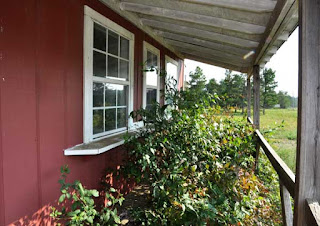During the early 1880's, prospectors came to the Rush area searching for silver mines they heard about from Indian legends. Soon, they found shiny metallic flakes in the rocks. Thinking they had struck silver, news of the discovery quickly got out and the rush was on to Rush.
 |
| The rock smelter built in 1886. |
 |
| General store built in 1891 remained in business until 1956. |
When World War 1 began, with the demand for brass and copper shell casings, the price for zinc shot up 300%, the mines expanded and more people moved to Rush. In 1916, the town was incorporated with a population of over 5,000. The Taylor-Medley General Store, built in 1891 by Bill Taylor to serve the community, became the location of the post office and served as the hub of the community where you could buy groceries, receive and send letters and packages, and sit a spell on the large, covered front porch and visit. You could also get married here because the store owner was, in addition to shop keeper and post master, also the justice of the peace.
 |
| Front porch of the store where people met and did business. |
With the end of WW1, the zinc market cratered. The mines began shutting down and the residents began moving away. Eventually even the Morning Star mine closed and that spelled the eventual death of Rush. The store, then operated by Lee Medley, was the last business to close it's doors in 1956. The last human holdout moved away sometime in the late 1960's and Rush began its life as a ghost town.
 |
| Row of homes built in the early 1900's. |
While there, I found it to be a really interesting place; way off the beaten path, quiet, full of history. The houses have a fence along the road in front of them, but more symbolic than functional, it's easy enough to get around it. Hopefully it will do enough of a job to keep out any vandals who manage to find the place. After walking around for over an hour with no other person to bother me, I took a water break and while sitting on a rock next to my truck, a butterfly landed on my shoulder. I slowly turned my head and looked at it looking at me. I've heard it's good luck so I didn't want to disturb it. It finally flew off, but only went down around my feet to some little bitty flowers so I took a picture of it before it went on its merry way. A few minutes later I hoped in the pickup to leave and as I drove down the dirt road a ways, I rounded a curve and a baby deer was standing in the middle of the road. I stopped and the mamma deer immediately jumped out of the bushes and both of them ran across and into the bushes and trees on the other side. I drove slowly and had to keep a sharp eye to find them hidden away. When I did, I stopped again and had just enough time to take a picture before mamma deer protectively put herself between me and her baby. I quietly told her, "It's ok. I'm not going to hurt your baby" and let the pickup idle on down the road a ways. By the time I turned around, they were gone.
 |
| Home to a family at one time. I wonder what became of them. |
 |
| My lucky butterfly |
 |
| Look close and you will find a mamma deer and her doe. |




















